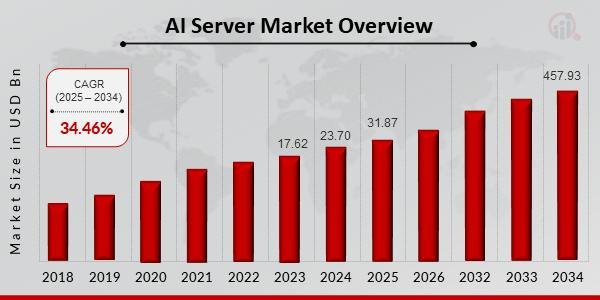Market Overview:
The AI server market is experiencing explosive growth, driven by the escalating demand for artificial intelligence across industries such as healthcare, finance, automotive, and IT. AI servers are specialized computing systems designed to support the high processing needs of machine learning, deep learning, and data analytics. With the increasing adoption of
AI applications and workloads that require high-performance computing capabilities, enterprises are upgrading their data infrastructure to support AI models, thereby boosting market expansion. AI Server Market is estimated to reach a valuation of USD 457.93 billion by the year 2034, at a CAGR of 34.46% during the forecast period 2025-2034.
The integration of advanced GPUs, TPUs, and neural processing units in servers is also pushing the limits of what AI can accomplish. According to industry reports, the global AI server market is projected to grow at a significant CAGR over the next decade, as businesses aim to unlock efficiency and productivity through AI-based solutions.
Market Key Players:
Key players dominating the AI server market include industry giants and innovative startups alike. Major companies such as IBM Corporation, Dell Technologies, NVIDIA Corporation, Hewlett Packard Enterprise (HPE), Lenovo Group, Super Micro Computer, Cisco Systems, and Huawei Technologies have made significant investments in developing AI-optimized servers and architectures. NVIDIA, in particular, plays a pivotal role with its GPUs and AI-focused computing platforms like DGX systems.
Other players such as AMD and Intel are also ramping up production of AI chips and CPUs with integrated machine learning capabilities. These companies are engaging in partnerships, mergers, and acquisitions to strengthen their position and expand their global reach. Moreover, cloud service providers such as Amazon Web Services (AWS), Microsoft Azure, and Google Cloud are continuously launching AI-accelerated server instances to meet the demands of AI-powered applications.
Download Research Sample with Industry Insights: https://www.marketresearchfuture.com/sample_request/22588
Market Segmentation:
The AI server market is segmented based on component, server function, server type, deployment mode, end-user, and region. By component, the market is categorized into hardware, software, and services. In terms of server function, segments include training servers, inference servers, and hybrid servers. Based on server type, the market is divided into rack servers, blade servers, and tower servers.
By deployment mode, it is bifurcated into on-premise and cloud-based servers. On the end-user front, the market serves various sectors including BFSI, healthcare, automotive, IT & telecom, retail, and government. Regionally, the market is segmented into North America, Europe, Asia-Pacific, Latin America, and the Middle East & Africa. Each segment has unique requirements and growth potential depending on AI adoption trends and technological readiness.
Market Drivers:
One of the primary drivers of the AI server market is the unprecedented rise in data generation and the need for real-time data processing and analytics. As businesses increasingly rely on insights derived from data, the demand for AI-powered servers capable of processing vast amounts of information in milliseconds is surging. The rapid growth of AI in autonomous vehicles, predictive maintenance, smart cities, and natural language processing (NLP) further fuels the market.
Additionally, the evolution of 5G networks and IoT is expanding the AI ecosystem, pushing the need for robust backend infrastructure powered by AI servers. Another key driver is the increasing investment by governments and enterprises in AI research and development, which necessitates sophisticated computing environments. The acceleration in adoption of generative AI models and large language models (LLMs) like ChatGPT, Bard, and Claude is also placing higher demands on server performance, thereby elevating market growth.
Buy this Premium Research Report at: https://www.marketresearchfuture.com/checkout?currency=one_user-USD&report_id=22588
Market Opportunities:
The AI server market presents several exciting opportunities for growth and innovation. The growing adoption of cloud-based AI servers by small and medium enterprises (SMEs) opens new revenue channels, as these businesses seek scalable, cost-effective AI solutions without the burden of large capital expenditure. There is also a rising need for energy-efficient AI servers, which can reduce operational costs and carbon footprints while maintaining high computational capabilities creating a niche for eco-friendly server design.
Additionally, the integration of edge AI servers for real-time decision-making in remote locations, especially in sectors like manufacturing, healthcare, and agriculture, is another lucrative opportunity. Markets in emerging economies, especially in Asia-Pacific and Latin America, are adopting AI at a rapid pace, offering untapped potential for server providers. Innovations in AI chipsets and server cooling technologies also offer companies the chance to differentiate their offerings and gain competitive advantages.
Regional Analysis:
In terms of regional performance, North America leads the global AI server market due to early AI adoption, robust digital infrastructure, and the presence of major tech giants. The U.S. in particular dominates in AI server development and deployment, backed by large-scale data centers and government initiatives supporting AI advancement. Europe follows closely, with countries like Germany, the U.K., and France investing heavily in AI research, particularly in healthcare and automotive applications. However, the fastest-growing region is undoubtedly Asia-Pacific, where countries like China, Japan, South Korea, and India are aggressively investing in AI technology and infrastructure.
China’s ambition to become the global AI leader by 2030 has led to massive investments in AI server farms and semiconductor development. Meanwhile, India’s digital transformation journey, paired with its booming IT sector, is fueling the demand for AI-powered servers. Other regions, including Latin America and the Middle East & Africa, are gradually catching up by integrating AI in sectors like energy, fintech, and e-commerce.
Browse In-depth Market Research Report: https://www.marketresearchfuture.com/reports/ai-server-market-22588
Industry Updates:
The AI server industry continues to witness dynamic transformations and breakthroughs. Recently, NVIDIA announced its Blackwell platform, which claims to deliver breakthrough AI computing performance for training trillion-parameter models-pushing the limits of what AI servers can handle. Similarly, HPE launched AI-native server platforms optimized for hybrid environments, enabling enterprises to run training and inference across cloud and edge seamlessly. Tech companies are also forming strategic alliances, such as the partnership between AMD and Microsoft to enhance AI server efficiency on Azure.
Startups are emerging with custom AI server solutions tailored for specific industries such as genomics, financial modeling, or security surveillance. Additionally, regulatory bodies are beginning to introduce AI-specific guidelines and standards for data handling and ethical computing, which will further shape how AI servers are designed and deployed. The rise of open-source AI server frameworks is also democratizing access to advanced AI tools, creating new pathways for innovation.
The AI server market is at the forefront of a technological revolution, supporting the infrastructure required for artificial intelligence to thrive across sectors. With growing demand for high-performance, energy-efficient, and scalable computing solutions, AI servers are becoming indispensable assets for organizations worldwide. Innovations in server architecture, processor technology, and deployment models continue to reshape the market landscape.
As AI applications expand into every corner of society from smart healthcare to intelligent manufacturing-the market for AI servers is poised for sustained growth, offering abundant opportunities for both established firms and emerging players. Businesses that invest in the right AI server technologies today are positioning themselves for a smarter, more efficient, and data-driven future.
Explore Our Latest Trending Reports:
Canada Fitness App Market- https://www.marketresearchfuture.com/reports/canada-fitness-app-market-46010
China Fitness App Market- https://www.marketresearchfuture.com/reports/china-fitness-app-market-46015
France Fitness App Market- https://www.marketresearchfuture.com/reports/france-fitness-app-market-46009
GCC Fitness App Market- https://www.marketresearchfuture.com/reports/gcc-fitness-app-market-46011
Germany Fitness App Market- https://www.marketresearchfuture.com/reports/germany-fitness-app-market-46007
About Market Research Future:
At Market Research Future (MRFR), we enable our customers to unravel the complexity of various industries through our Cooked Research Report (CRR), Half-Cooked Research Reports (HCRR), Raw Research Reports (3R), Continuous-Feed Research (CFR), and Market Research & Consulting Services.
MRFR team have supreme objective to provide the optimum quality market research and intelligence services to our clients. Our market research studies by products, services, technologies, applications, end users, and market players for global, regional, and country level market segments, enable our clients to see more, know more, and do more, which help to answer all their most important questions.
Also, we are launching “Wantstats” the premier statistics portal for market data in comprehensive charts and stats format, providing forecasts, regional and segment analysis. Stay informed and make data-driven decisions with Wantstats.
Contact Us:
Market Research Future (Part of Wantstats Research and Media Private Limited)
99 Hudson Street, 5Th Floor
New York, NY 10013
United States of America
+1 628 258 0071 (US)
+44 2035 002 764 (UK)
Email: sales@marketresearchfuture.com
Website: https://www.marketresearchfuture.com
This release was published on openPR.
















